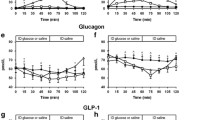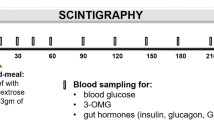Abstract
We have compared responses to an ordinary solid-liquid (S) meal and to a homogenized (H) meal of identical composition (sirloin steak, bread, butter, ice cream with chocolate syrup, and water) by measuring simultaneously postprandial gastric, pancreatic, and biliary functions by marker-perfusion techniques. Responses to each (S or H) meals differed strikingly both in magnitude and pattern. S meals elicited a stronger early gastric secretory response (acid, pepsin, and volume) which compensated for faster initial emptying and resulted in higher gastric acidity and volume than after H meals. Further, nutrients ingested with S meals were emptied at a slower rate than H (as evidenced by a more gradual decline in intragastric buffer and osmolality, as well as time required for complete emptying of the meal). This, in turn, prolonged pancreatic and biliary responses since stimulation of these organs continued for as long as meal was delivered into the duodenum. However, early biliary outputs (gallbladder response) were less after S than H, probably because nutrients entered the duodenum more slowly and were initially diluted by rapidly emptying water. The physical characteristics of each meal (encompassing appearance, taste, and form of ingestion) probably accounted for early differences in digestive responses. Later, interactions between gastric (motor and secretory), pancreatic, and biliary functions played a major role. Our findings suggest that gastric, pancreatic, and biliary responses to liquid test meals introduced into the stomach may differ substantially from the presumably more physiological response to ordinary solid-liquid meals.
Similar content being viewed by others
References
Walsh JC, Richardson CT, Fordtran JS: pH dependence of acid secretion and gastrin release in normal and ulcer subjects. J Clin Invest 55:462–468, 1975
Cooke AR, Moulang J: Control of gastric emptying by amino acids. Gastroenterology 62:528–532, 1972
Konturek SJ, Biernat J, Oleksy J: Serum gastrin and gastric acid responses to meals at various pH levels in man. Gut 15:526–530, 1974
Henn RM, Isenberg JI, Maxwell V, Sturdevant RAL: Inhibition of gastric acid secretion by cimetidine in patients with duodenal ulcer. N Engl J Med 293:371–375, 1975
Brunner H, Northfield TC, Hofmann AF, Go VLW, Summerskill WHJ: Gastric emptying and secretion of bile acids, cholesterol, and pancreatic enzymes during digestion: Duodenal perfusion studies in healthy subjects. Mayo Clin Proc 49:851–860, 1974
Johansson C, Lagerlof JO, Ekelun K, Kulsdom N, Larsson I, Nylind B: Determination of gastric secretion and evacuation, biliary and pancreatic secretion, intestinal absorption, intestinal transit time and flow of water in man. Scand J Gastroenterol 7:489–499, 1972
Richardson CT, Bailey BA, Walsh JH, Fordtran JS: The effect of an H2-receptor antagonist on food-stimulated acid secretion, serum gastrin, and gastric emptying in patients with duodenal ulcers: Comparison with an anticholinergic drug. J Clin Invest 55:536–542, 1975
Rhodes J, Barnardo DE, Phillips SF, Rovelstad RA, Hofmann AF: Increased reflux of bile into the stomach of patients with gastric ulcer. Gastroenterology 57:241–252, 1969
Malagelada J-R, Longstreth GF, Summerskill WHJ, Go VLW: Measurement of gastric functions during digestion of ordinary solid meals in man. Gastroenterology 70:203–210, 1976
Fordtran JS, Walsh JH: Gastric acid secretion rate and buffer content of the stomach after eating. J Clin Invest 52:645–657, 1973
Malagelada J-R: Quantification of gastric solid-liquid discrimination during digestion of ordinary meals. Gastroenterology 72:1264–1267, 1977
Chang CA, McKenna RD, Beck IT: Gastric emptying rate of the water and fat phases of a mixed test meal in man. Gut 9:420–424, 1968
Meyer JH, MacGregor IL, Gueller T, Martin P, Cavalieri R:99mTc-tagged chicken liver as a marker of solid food in the human stomach. Am J Dig Dis 21:296–304, 1976
Moore JG, Schenkenberg T: Psychic control of gastric acid: Response to anticipated feeding and biofeedback training in man. Gastroenterology 66:954–959, 1974
Crawshaw HM, Fraser DM, Warrender TS: Can psychic stimulation cause gastric acid secretion in man? Lancet 2:66–68, 1968
Sarles H, Dani T, Prezelin G, Souville C, Figarella C: Cephalic phase of pancreatic secretion in man. Gut 9:214–221, 1968
Longstreth GF, Malagelada J-R, Go VLW: The gastric response to a transpyloric duodenal tube. Gut 16:777–780, 1975
Berstad A: A modified hemoglobin substrate method for the estimation of pepsin in gastric juice. Scand J Gastroenterol 5:343–348, 1970
Sizemore GW, Go VLW, Kaplan EL, Sanzenbacher LS, Holtermuller KH, Arnaud CD: Relations of calcitonin and gastrin in the Zollinger-Ellison syndrome and medullary carcinoma of the thyroid. N Engl J Med 288:641–644, 1973
Dixon WJ, Massey FJ, Jr: Introduction to statistical analysis, third edition. New York, McGraw-Hill, 1969
Debas HT, Grossman MI: Chemicals bathing the oxyntic gland area stimulate acid secretion in dog. Gastroenterology 69:654–659, 1975
Grossman MI: The chemicals that activate the “on” switches of the oxyntic cell. Mayo Clin Proc 50:515–518, 1975
Levitt MD, Bond J: Use of the constant perfusion technique in the non-steady state. Gastroenterology 73:1450–1452, 1977
Meeroff JC, Go VLW, Phillips SF: Control of gastric emptying by osmolality of duodenal contents in man. Gastroenterology 68:1144–1151, 1975
Cooke AR: Duodenal acidification: Role of first part of duodenum in gastric emptying and secretion in dogs. Gastroenterology 67:85–92, 1974
Malagelada J-R, Go VLW, Summerskill WHJ: Differing sensitivities of gallbladder and pancreas to cholecystokinin-pancreozymin (CCK-PZ) in man. Gastroenterology 64:950–954, 1973
Malagelada J-R, Go VLW, DiMagno EP, Summerskill WHJ: Interactions between intraluminal bile acids and digestive products on pancreatic and gallbladder function. J Clin Invest 52:2160–2165, 1973
Holtermuller KH, Malagelada J-R, McCall JT, Go VLW: Pancreatic, gallbladder and gastric functions during intraduodenal calcium perfusion in man. Gastroenterology 70:693–696, 1976
Vlahcevic ZR, Bell CC Jr, Swell L: Significance of the liver in the production of lithogenic bile in man. Gastroenterology 59:62–69, 1970
Author information
Authors and Affiliations
Additional information
Dr. Summerskill died March 9, 1977.
This investigation was supported in part by Research Grant AM 6908 from National Institutes of Health.
Rights and permissions
About this article
Cite this article
Malagelada, JR., Go, V.L.W. & Summerskill, W.H.J. Different gastric, pancreatic, and biliary responses to solid-liquid or homogenized meals. Digest Dis Sci 24, 101–110 (1979). https://doi.org/10.1007/BF01324736
Issue Date:
DOI: https://doi.org/10.1007/BF01324736




